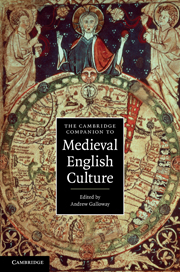Book contents
- Frontmatter
- Introduction
- Part one Theaters of culture: political, legal, material
- Part two Cultural ideals and cultural conflicts
- Part Three Literacies, languages, and literatures
- 7 Visual texts in post-Conquest England
- 8 Literacy, schooling, universities
- 9 Anglo-Latin literature in the later Middle Ages
- 10 The vernaculars of medieval England, 1170-1350
- 11 English literary voices, 1350-1500
- Part four Legacies and re-creations
- Guides to further reading
- Index
9 - Anglo-Latin literature in the later Middle Ages
from Part Three - Literacies, languages, and literatures
Published online by Cambridge University Press: 28 July 2011
- Frontmatter
- Introduction
- Part one Theaters of culture: political, legal, material
- Part two Cultural ideals and cultural conflicts
- Part Three Literacies, languages, and literatures
- 7 Visual texts in post-Conquest England
- 8 Literacy, schooling, universities
- 9 Anglo-Latin literature in the later Middle Ages
- 10 The vernaculars of medieval England, 1170-1350
- 11 English literary voices, 1350-1500
- Part four Legacies and re-creations
- Guides to further reading
- Index
Summary
Anglo-Latin origins
Latin is a language of intimidation. This property is the reverse face of its more often remarked ecumenicism. Latin spread but did not attain the geographical diffusion of the Greek-language oikoumenê of Hellenistic antiquity, or the Arabic of the Islamic diaspora, or the Spanish of the early Modern period, or the English of modern industrial imperialism, nor did it gain comparable numbers of users. It spread but did not deepen as Latin after antiquity: restricted to use among thin layers of the European population, selected and self-selecting by education, matters of class, and gender. For almost all of those who have used it, even in antiquity, Latin has been an acquired, second language, more and less discontinuous with forms of everyday speech. As a second language, the high-cultural Latinity enabled something like transnational communication among persons otherwise cut off from one another by differences of natural language – what W. Martin Bloomer has described as its “liberating” function – but only among the few, only engaged in a restricted, specialized range of transactions: “Learning Latin removes (liberates) the individual from the familial and the local and the present, but it is an oppressive business.” Latin’s influence, its historical importance or significance, is not so much a function of its diffusion or consequent intermittent facilitation of international communications, as it is a function of its exclusivity, in subordinate relation to the specific, transferable kinds of political-economic power, in the wake of which the language trailed.
- Type
- Chapter
- Information
- The Cambridge Companion to Medieval English Culture , pp. 195 - 216Publisher: Cambridge University PressPrint publication year: 2011
- 1
- Cited by



